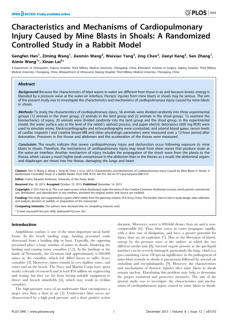Scientific papers 2013









Author:
Paul C. Alga
Most diving companies use the protocol proposed and
tested by Dr. E. Thalmann (US Navy) to fight otitis externa
that affects numerous saturation divers. This method
reduces the rate of infections from 75% to 0%. However, it
has been observed that some divers experience side
effects from this treatment. These side effects include
erythema and cracking of the outer ear canal to
crystallization throughout the external canal and on the
tympanic membrane. This document from the US Navy
Experimental Diving Unit discusses a new protocol to
avoid these side effects without diminishing the
treatment's efficiency initially promoted by Dr. Thalman.


Authors:
Jean-Eric Blatteau, Julien Hugon, Olivier Castagna, Cédric
Meckler, Nicolas Vallée, Yves Jammes, Michel Hugon, Jan
Risberg, and Christophe Pény.
Recent advances in submarine rescue systems enable the
safe transfer of crew members from disabled submarines
under pressure. While safe decompression procedures
have been discussed, none have been validated for
pressures over 2.8 bar. This study tested a saturation
decompression procedure at pressures up to 6 bar,
focusing on decompression sickness and pulmonary
oxygen toxicity.
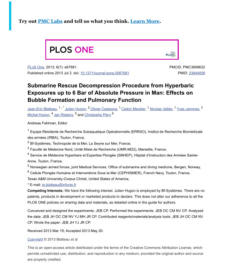



Authors:
A D Cornet, A J Kooter, M JL Peters, Y M
Smulders
In medical emergencies, supplemental oxygen is often
administrated routinely. Most paramedics and physicians
believe that high concentrations of oxygen are life-saving.
Over the last century, however, a plethora of studies point
to the possible detrimental effects of hyperoxia induced by
supplemental oxygen in a variety of medical emergencies.
This viewpoint provides a historical overview and
questions the safety of routine high-dose oxygen
administration and is based on pathophysiology and
(pre)clinical findings in various medical emergencies.
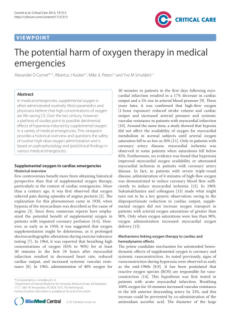

Authors:
O. Castagna, J. E. Blatteau, N. Vallee, B. Schmid, J.
Regnard.
This study aimed at demonstrating that the neoprene
wetsuit provides not only thermal protection. The
compression it exerts on the diver’s shell
significantly impacts hydromineral homeostasis by
restraining the systemic vascular capacity and
secondarily increasing urine output on dry land
and during scuba diving.


Authors:
Stephen R. Thom, Tatyana N. Milovanova, Marina Bogush,
Ming Yang, Veena M. Bhopale, Neal W. Pollock, Marko
Ljubkovic, Petar Denoble, Dennis Madden, Mislav Lozo,
and Zeljko Dujic.
The study goal was to evaluate responses in humans
following decompression from open-water SCUBA diving
with the hypothesis that exertion underwater and use of a
breathing mixture containing more oxygen and less
nitrogen (enriched air nitrox) would alter annexin V-
positive microparticle (MP) production and size changes
and neutrophil activation, as well as their relationships to
intravascular bubble formation.
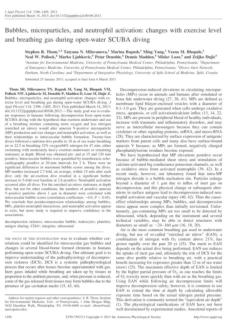

Authors:
Jean-Eric Blatteau, Alf O. Brubakk, Emmanuel Gempp,
Olivier Castagna, Jean-Jacques Risso, Nicolas Vallee.
The use of sildenafil, a well-known phosphodiesterase-5
blocker, which acts by potentiating the vasodilatory effect
on smooth muscle relaxation, has never been studied in
DCS. The purpose of the present study was to evaluate
the clinical effects of sildenafil pre-treatment on DCS in a
rat model. Sixty-seven rats were subjected to a simulated
dive at 90 msw for 45 min before staged decompression.
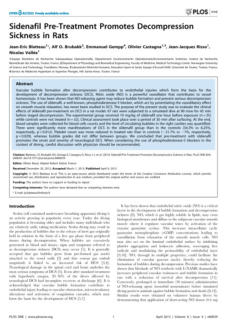

Authors:
Nicolas Vallée, Sandrine Gaillard, André Peinnequin, Jean-
Jacques Risso, & Jean-Eric Blatteau.
The use of sildenafil, a well-known phosphodiesterase-5
blocker, which acts by potentiating the vasodilatory effect
on smooth muscle relaxation, has never been studied in
DCS. The purpose of the present study was to evaluate
the clinical effects of sildenafil pre-treatment on DCS in a
rat model. Sixty-seven rats were subjected to a simulated
dive at 90 msw for 45 min before staged decompression.
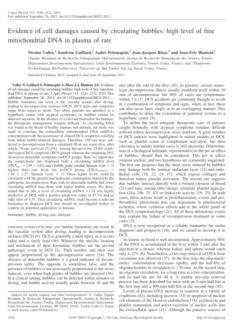

Authors: E Gempp, P Louge, T Lafolie, S Demaistre, M.
Hugon, JE. Blatteau.
This study investigate the relationship between vertebral
degenerative changes resulting in spinal canal, spinal cord
lesions, and the devellopment of spinal cord
decompression sickness (DCS) in scuba divers.


This document is taken into reference by scientists
performing experimentations.
The World Medical Association (WMA) serves as a
clearinghouse of ethics information resources for its
members. The WMA cooperates with academic
institutions, global organizations, and individual experts to
achieve this goal. The documents it publishes are
recognized as the international ethical standard for the
topics they address.


Authors:
D. J. Harriss, G. Atkinson
The ethical standards indicated in this document are also
taken into reference by scientists performing
experimentations.


Authors: Marco B. Hansen, Tejs Jansen, Michael B. Sifakis,
Ole Hyldegaard , Erik C. Jansen.
This study evaluated the feasibility and safety of using
nitrox 50 as breathing gas during attendance in a
hyperbaric chamber.
Paper logs were reviewed to analyze nitrogen gas-
loading, actual bottom time, total bottom time, and
surface interval time. With the Norwegian Diving Tables,
nitrogen gas-loading was converted to repetitive group
Letters. Symptoms of decompression sickness and health
problems related to hyperbaric exposures were registered
at weekly staff meetings. The chamber personnel
breathed chamber air or Nitrox 50.


Authors: Dylan Thompson, Alan M. Batterham
There has been some discussion of whether it is possible
to score highly in one dimension of physical activity
behaviour (e.g., moderate-intensity exercise) while scoring
poorly in another (e.g., sedentary time). Interestingly,
direct empirical observations to support these proposals
are lacking. New technologies now capture physical
activity thermogenesis on a minute-by-minute basis and
over a sustained period. The authors used one of the best
available technologies to explore whether individuals can
score differently in various physiologically-important
physical activity dimensions.
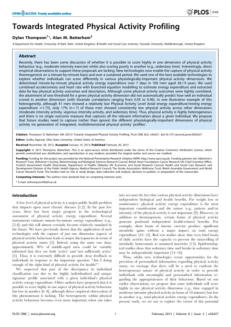

Authors: Virginie Papadopoulou, Robert J. Eckersley,
Costantino Balestra, Thodoris D. Karapantsios,
Meng-Xing Tang.
Bubbles are known to form in the body after scuba dives,
even those done well within the decompression model
limits. These can sometimes trigger decompression
sickness, and the dive protocols should therefore aim to
limit bubble formation and growth from hyperbaric
decompression. Understanding these processes
physiologically has been a challenge for decades, and
there are a number of questions still unanswered. The
physics and historical background of this field of study are
presented, and the latest studies and developments are
reviewed.


Authors: Sigrid Theunissen, Julie Schumacker, Franc¸ois
Guerrero, Frauke Tillmans, Antoine Boutros, Kate
Lambrechts, Aleksandra Mazur, Massimo Pieri,
Peter Germonpre, & Costantino Balestra
The aim of this study is to observe the effects of dark
chocolate on endothelial function after a series of
successive apnea dives in non-thermoneutral water.


Authors: Ibiam Fa, Obasikene Godwin, Basil Ezeanolue
Several agents involving mono or multi-therapy have
been used over the years in the treatment of acute otitis
externa with varying results. In this study The authors
considered the response pattern of acute otitis externa to
a tripple regimen of steroid, antibacterial and an anti-
fungal medication in our center.


Authors:
Dorota Kaczerska, Piotr SiermontowskiOlszansk, Karolina
Krefft, Sylwia Małgorzewicz, Katarzyna Van Damme-
Ostapowicz
Cases of decompression sickness are observed despite the
correct application of decompression tables. For this
reason, this study investigated factors affecting the safety
of diving, with a particular emphasis on diet, which, thus
far, has not been taken into account.
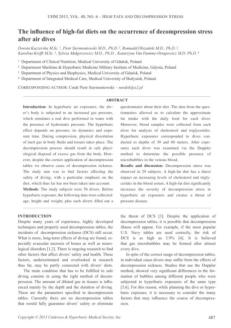

Authors: David J. Doolette, Wayne A. Gerth
Inner ear decompression sickness (DCS) has followed
deep breathing gas switches to air (or other nitrogen-
oxygen mixtures) during decompression from deep heliox
dives. This study investigates the safety of heliox-to-air
breathing gas switches at moderate depths.
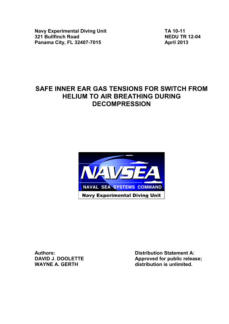

Authors:
Andrea Cortegiani, Grazia Foresta, Giustino Strano, Maria
Teresa Strano, Francesca Montalto, Domenico Garbo,
and Santi Maurizio Raineri
Some cases of decompression illness are known to have
occurred among breath-hold (BH) divers also, and they
are reported in the medical literature. A male BH diver (57
years old), underwater fishing champion, presented
neurological disorders as dizziness, sensory numbness,
blurred vision, and left frontoparietal pain after many
dives to a 30–35 meters sea water depth with short
surface intervals.
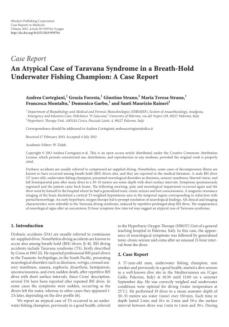

Authors: Xavier CE Vrijdag, Pieter-Jan AM van Ooij, and
Robert A van Hulst
This study evaluates the benefits of argon, compared to
air, as a thermal insulation gas for a dry suit during a 1-h
cold-water dive by divers of the Royal Netherlands Navy.
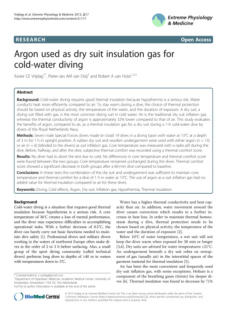

Authors: Arve Jørgensen, Philip P. Foster, Alf O. Brubakk, &
Ingrid Eftedal
The aim of this study was to investigate the effect of
diving-induced venous gas emboli (VGE) formation on
cardiac stress marker levels and the cardioprotective effect
of hyperbaric oxygen preconditioning (HBO-PC). To
induce high loads of VGE, 63 female Sprague – Dawley
rats were subjected to a rapid ambient pressure reduction
from a simulated saturation dive (50 min at 709 kPa) in a
pressure chamber.
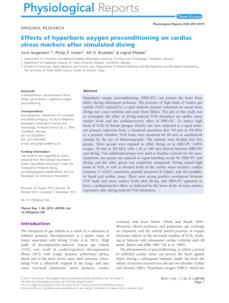


Click on the octopus
to return to the top
of the page

Authors: Thomas Randsoe and Ole Hyldegaard
High altitude can cause decompression sickness (DCS).
Studies have shown that venous gas embolism (VGE)
and DCS incidence rise sharply when ambient pressure
exceeds 40–44 kPa. Moreover, experiments suggest that
these bubbles can grow and stabilize at 25 kPa, but tend
to shrink and disappear at 71 kPa when breathing
oxygen. The authors hypothesize that a specific ambient
pressure threshold, between 25 and 71 kPa, may
determine whether these bubbles stabilize or disappear.
The results showed that more bubbles shrank and
disappeared at 60 and 47 kPa than at 36 kPa.
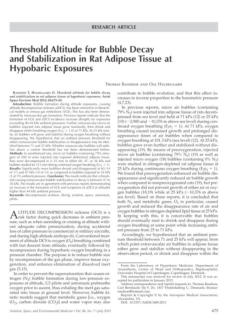

Authors: Kate Lambrechts, Jean-Michel Pontier,
Aleksandra Mazur, Peter Buzzacott, Jean Morin,
Qiong Wang, Michael Theron, & Francois
Guerrero
This study explored post-dive vascular dysfunction
mechanisms in divers using three protocols: a 30-minute
SCUBA dive at 400 kPa, a 41-minute seawater surface
finning exercise, and a 41-minute simulated dive with
100% oxygen at 170 kPa. Doppler-monitored bubble
grades and vascular function were assessed. The results
showed no significant change in endothelium-dependent
reactivity after the SCUBA dive, but there was a notable
decrease in endothelium-independent response.
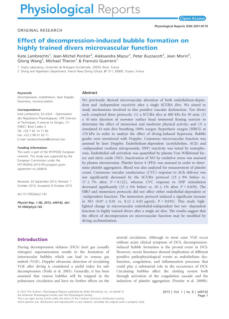

Authors:
Ji Won Park, Barbora Piknova, Paul L. Huang, Constance T.
Noguchi, Alan N. Schechter
This document presents the findings of a scientific study
that investigates the role of dietary nitrite and nitrate in
regulating platelet function and their potential impact on
thrombosis and hemostasis. It explores how manipulating
nitrite and nitrate levels in mice through various methods,
including diet and supplementation, affects platelet
aggregation, ATP release, and bleeding time. The results
suggest that endogenous nitrite and nitrate levels could
serve as biomarkers for predicting platelet function and
that dietary changes may influence thrombotic processes.
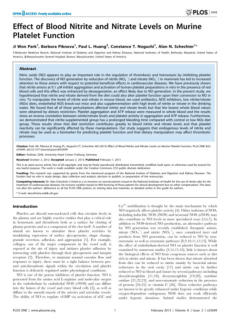

Authors:
Anke Neidig, Amy T.Y. Yeung, Thibaut Rosay, Beatrix
Tettmann, Nikola Strempel, Martina Rueger, Olivier
Lesouhaitier, and Joerg Overhage
This paper presents scientific research findings on the role
of the TypA GTPase in the virulence of Pseudomonas
aeruginosa. It outlines the background of the study, the
experimental results, and the conclusions drawn from the
research. Specifically, it aims to communicate that
mutation of the typA gene in P. aeruginosa leads to
reduced virulence, impaired biofilm formation, and
decreased antibiotic resistance, thereby identifying TypA
as a significant modulator of the pathogen's virulence.


Authors:
Sigrid Theunissen, Nicola Sponsiello, Miroslav Rozloznik,
Peter Germonpré, François, Guerrero, Danilo Cialoni and
Costantino Balestra
This paper discusses a scientific study that investigates the
effects of repetitive breath-hold diving on plasma oxidative
stress markers. It analyzes how such diving activities
influence levels of nitric oxide (NO), peroxynitrite
(ONOO–), and thiols (R-SH) in the blood to understand
the physiological changes and oxidative stress associated
with breath-hold diving.


Authors: Ingrid Eftedal, Marko Ljubkovic, Arnar Flatberg,
Arve Jørgensen, Alf O. Brubakk, and Zeljko Dujic
This study investigates the physiological effects of scuba
diving on the human circulatory system, specifically
focusing on the changes in the blood transcriptomes of
experienced divers. The study aims to identify genes,
biological pathways, and cell types that are affected by
the stress of scuba diving, even in the absence of
symptoms. The research involves analyzing blood samples
from divers before and after a series of dives, comparing
them to non-divers, and identifying significant changes in
gene expression related to apoptosis, inflammation, and
immune responses.
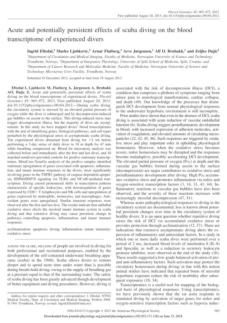

Authors:
Walter Hemelryck, Miroslav Rozloznik, Peter Germonpré,
Costantino Balestra and Pierre Lafère
This study evaluates the reliability of using critical flicker
fusion frequency (CFFF) to measure cognitive function,
particularly in the context of inert gas narcosis, comparing
CFFF with other cognitive tests to assess the impact of
breathing 100% normobaric oxygen on mental
performance. The results suggest that CFFF is a reliable
measure that correlates with other cognitive tests and
could be used in various operational environments, such
as diving. The authors conclude by suggesting further
research to explore the effects of different pressures and
gas mixtures on cognitive function during diving.
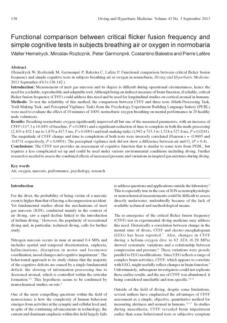



04 - Patent foramen ovale and scuba diving: a practical guide for
physicians on when to refer for screening
- Published by Extreme Physiology of Medicine

Authors: Oliver Sykes, and James E Clark
Divers learn basic physiology in training, leading to
concerns about patent foramen ovale (PFO) and
decompression illness (DCI). While routine PFO screening
for all divers is not recommended, guidelines for selective
screening are unclear. The text provides information on
existing guidelines, advice for management, and suggests
which divers should consider PFO screening.
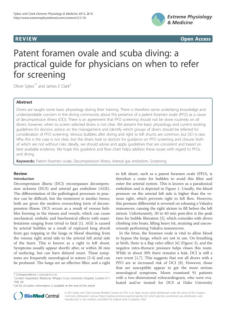

Author: Neal W. Pollock, Jaksa Zanchi, Marko Ljubkovic,
Petar J. Denoble, Zeljko Dujic, Shabbar I.
Ranapurwala
Presentation made for the Aerospace Medical Association
in May 2013


12 - Influence of repeated daily diving on decompression stress
- Published by Diver Alert Network (DAN)
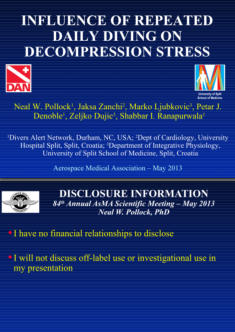



15 - A critical review of physiological bubble formation in hyperbaric
decompression
- Published by Science Direct
(Author-released)

Authors: Virginie Papadopoulou, Robert J. Eckersley,
Costantino Balestra, Thodoris D. Karapantsios,
Meng-Xing Tang
This document discusses ongoing challenges in
understanding these processes and reviews past studies
and recent developments. Heterogeneous nucleation is a
key factor in bubble formation, affected by surface
hydrophobicity and tissue elasticity. The relevance of
modeling bubble formation, growth, and multiple bubble
behavior is also addressed.
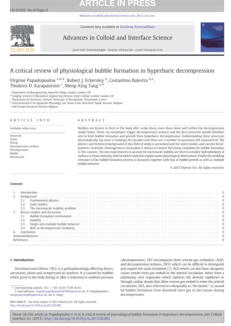



16 - Exercise after SCUBA diving increases the incidence of arterial
gas embolism.
- Published by the American Physiological Society
(Author-released)

Author: Dennis Madden, Mislav Lozo, Zeljko Dujic, and
Marko Ljubkovic
This study aimed to check if post-diving exercise raises the
rate of arterialization. After a dive, subjects were
monitored for bubbles at rest and during an exercise test.
Results showed that exercise increased arterialization from
13% at rest to 52%, confirming that individuals can
arterialize through IPAVA and that the exercise intensity
affects this process.




17 - Influence of Repeated Daily Diving on Decompression Stress
- Published by Thieme
(Author-released)

Author: J. Zanchi, M. Ljubkovic , P. J. Denoble, Z. Dujic, S.
Ranapurwala, N. W. Pollock
Acclimatization to diving may lower decompression stress
by reducing post-dive gas bubbles. This study examined if
four days of daily diving affected bubble grades. Sixteen
male divers completed the same dives over four days, with
monitoring of bubble grades. Results showed that the
likelihood of higher bubble grades decreased on
subsequent days, indicating that repeated diving could
lead to positive acclimatization. Further research is needed
to assess longer diving durations and their effects on
decompression sickness risk.
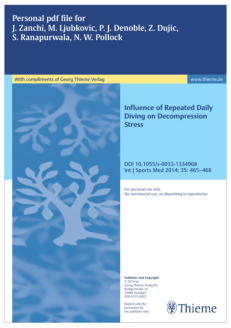



25 - Mathematical Models of Diffusion-Limited Gas Bubble Evolution
in Perfused Tissue.
- Published by the Navy experimental Diving Unit

Author: Ramachandra Srini Srinivasan, Wayne A. Gerth
This study aimed to check if post-diving exercise raises the
rate of arterialization. After a dive, subjects were
monitored for bubbles at rest and during an exercise test.
Results showed that exercise increased arterialization from
13% at rest to 52%, confirming that individuals can
arterialize through IPAVA and that the exercise intensity
affects this process.




Author: Cristina Zanotta, Dorothea Dagassan, Peter
Nussberger, Tuomas Waltimo, Andrea Filippi
This study focuses on dental and orofacial problems
caused by pressure variations. A survey of 520 pressure-
exposed individuals revealed 15% had dental issues, with
toothaches reported by 10. 2% and tooth injuries by 6.
3%. Recommendations for preventing barotraumas in
divers and caisson workers were created.
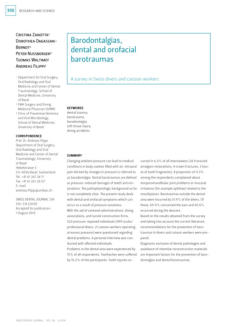


03 - Diffusion tensor MRI of spinal decompression sickness
- Published by the National Institute of Health

Authors: Elizabeth B. Hutchinson, Aleksey S. Sobakin,
Mary E. Meyerand, Marlowe Eldridge, and Peter
Ferrazzano
A study using diffusion tensor MRI (DTI) was used to
assess spinal decompression sickness (DCS)-related tissue
injury in sheep spinal cords. This study found that
decompression from >60 fsw reduced fractional
anisotropy, associated with cell death and disrupted
tissue microstructure in white matter tracts. Prolonged
oxygen pre-breathing also reduced mean diffusion in
gray matter regions. This is the first study to demonstrate
DTI's utility in investigating DCS-related injury.
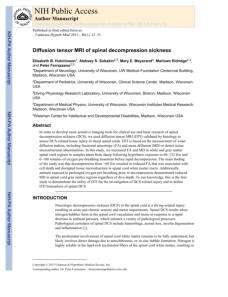



31 - Salivary Biomarkers: Toward Future Clinical and Diagnostic
Utilities.
- Published by the American Society for Microbiology

Authors: Janice M. Yoshizawa, Christopher A. Schafer,
Jason J. Schafer, James J. Farrell, Bruce J. Paster,
David T. W. Wong
The urgency of detecting pathologies early is crucial for
patient comfort, prognosis, and treatment. Diagnosis
often requires painful invasive procedures, but saliva-
based biomarkers offer unique opportunities. Saliva is a
significant indicator for local, systemic, and infectious
disorders, and recent discoveries suggest it can mediate
the body's physiological condition. Salivary diagnostics is
currently in its early stages of development.
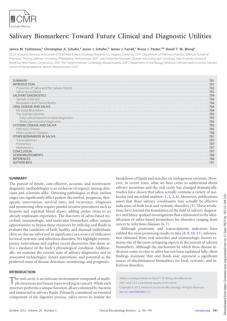

Authors: Young Il Lee, and Byeong Jin Ye
This article highlights the growing number of divers
globally, particularly in Korea, and the associated risks of
the underwater environment, such as barotrauma and
decompression sickness. It emphasizes the necessity for
primary care physicians to be knowledgeable about
diving-related injuries and fitness assessment for divers.
The article also advocates for underwater and hyperbaric
medicine (UHM) to be recognized as a distinct branch of
occupational and environmental medicine (OEM).
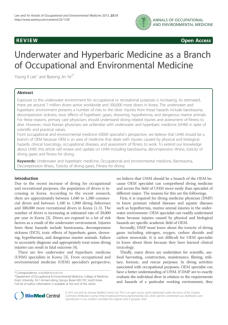

Authors: Gengfen Han, Ziming Wang, Jianmin Wang,
Weixiao Yang, Jing Chen, Jianyi Kang, Sen
Zhang, Aimin Wang, Xinan Lai
This study investigates the characteristics and mechanisms
of cardiopulmonary injuries resulting from mine blasts in
shoals, highlighting that these injuries differ significantly
from those experienced in air due to water’s unique
properties. Experiments on 56 animals demonstrated
severe cardiopulmonary dysfunction linked to shock
waves and shear waves created during detonations. The
study emphasizes the need for further understanding of
these injury mechanisms to improve safety in aquatic mine
environments.
